Improvised Design in the Siege of Sarajevo
Cut off from the outside world for four years by a besieging army, with food, water, electricity, fuel and weapons in short supply, the people of Sarajevo faced a daily choice: improvise and adapt or die.
Cover photo: Sarajevo in June 1992 during the height of the siege. Serbian forces outside the city continuously shelled the poorly armed Bosnian defenders. Inside the city, the Serbs controlled most of the major military positions and snipers took up strategic positions. By September 1993 it was estimated that virtually all the buildings in Sarajevo had suffered some degree of damage, and 35,000 of them, including hospitals and libraries, were completely destroyed. (Photo: Antoine Gyori/Sygma/Corbis)
Dr Stevan Šubara opens the kitchen window of his eighth-storey Sarajevo apartment, leans out, and points to the shallow river Miljacka, 300m (950ft) to his right. ‘Look,’ he says, ‘this was the front line.’ Twenty years earlier, the besieging Serb nationalist army had lain beyond it, firing mortars, shells and sniper rounds across the water every day. ‘The Bosnian army,’ says Šubara, turning left to gesture the same distance uphill, ‘were shooting from there, trying to aim between the buildings.’ Reaching out around the frame, he taps a huge metal plate fastened to the exterior wall. ‘And this is where the shell hit. It was about two in the morning, and we were sleeping on the floor. Ten centimetres (4in) to the right and it would have hit our bed.’
The Serb nationalist blockade of Sarajevo was the longest siege in modern warfare. Beginning on April 5, 1992, when gunmen opened fire on a peace rally, it lasted almost four years. During that whole time Stevan and Majda Šubara lived in their apartment in the 20-storey tower at 11 Kolodvorska Street, one minute’s walk from the notorious ‘Sniper Alley’. The safest place on the eighth storey was the communal landing next to the elevator, and the Šubaras, like their neighbours Ismet Milak and Mustafa and Fatima Dizdarević, spent most of their time there. Milak and the Dizdarevićes were Bosnian Muslims, and with Stevan, a Serb, and Majda, a Croat, they formed a typically Sarajevan mix of ethnicities. Formerly strangers, they quickly became ‘like one family,’ says Fatima, thrown together by the conflict.
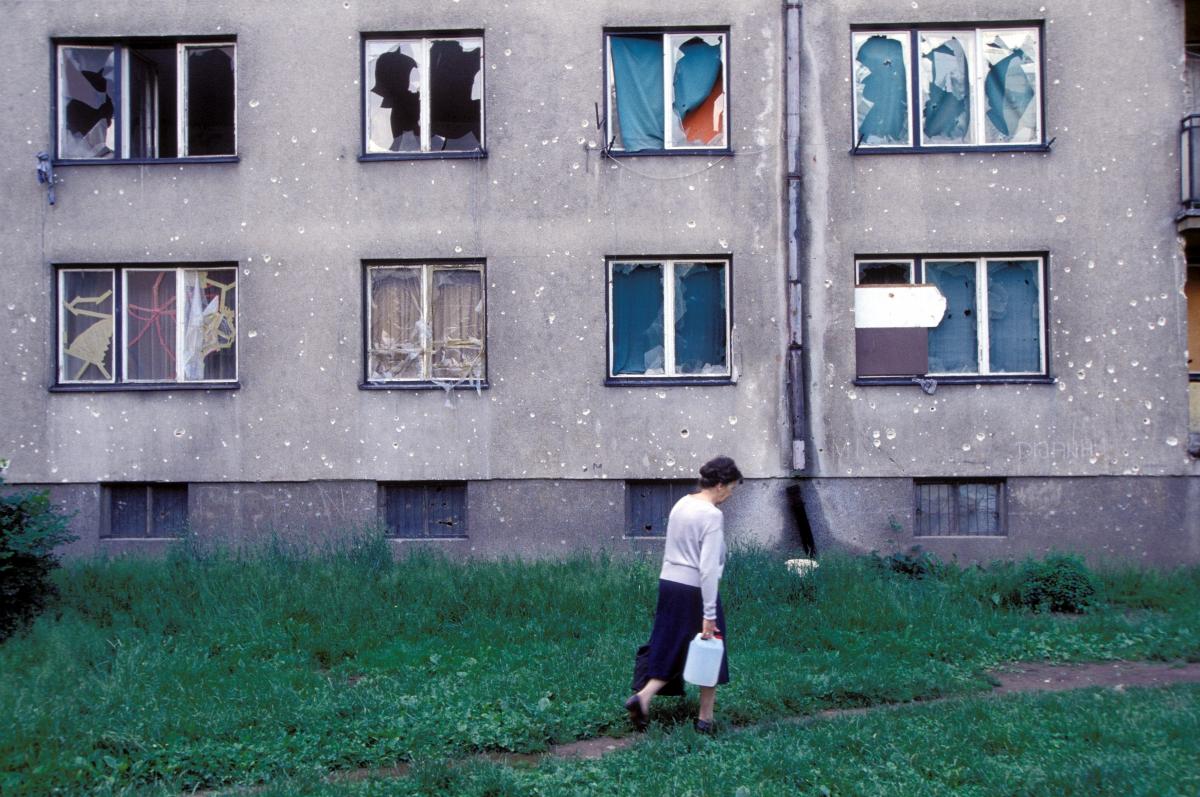
June 1995. A woman traverses Grbavica quarter, the scene of intensive street fighting during the siege, carrying a water container from the public cisterns. During the periods when the Serb nationalists cut off the water supply, this was a risky and laborious task that had to be performed at least once daily. (Photo courtesy of Gamma Presse Images / Hollandse Hoogte.)
‘We never imagined that there would be a war,’ says Milak, ‘and as soon as it seemed imminent, the supermarkets emptied out. We had plenty of money, but it was all in bank accounts, and then the banks closed. We had fridges full of food, but no electricity. To stop the food spoiling, we had to boil it, but the water was turned off. We couldn’t move around the city. People were being killed all the time. And things got worse with the winter. No wood. No food. No water. Just war. You had to find ways to survive.’
For these neighbours on the eighth storey of 11 Kolodvorska Street, improvisation became a way of life, just as it did for all 435,000 people trapped inside a strip of city 13km (8mi) long and 5km (3mi) wide. For four years, Sarajevans subsisted on meagre humanitarian aid, drank from wells, foraged for food and scavenged for fuel. Their gas, electricity and water mains ran through the territory held by the Serb nationalists, who switched them on infrequently and irregularly as part of a comprehensive campaign to inflict psychological distress.
Winding east to west along the Miljacka river, Sarajevo is flanked on every side by steep hills from which the Serb nationalist army rained shells onto the inhabitants—an average of 329 a day in the first two years of the war—while snipers, sighting along the wide streets, conducted executions of random civilians. By the time the siege was over, approximately 30,000 civilians had been wounded and at least 4,954 killed, including 1,601 children. ‘Don’t let them sleep,’ Bosnian Serb military leader Ratko Mladić ordered his men in May 1992. ‘Drive them crazy.’
By then, in the words of Milak, shells were ‘falling like pears’. Many Sarajevans had sheltered in basements and bunkers for the first weeks of the war, but by the end of April most had already returned to their homes. Life had to go on, and urgent new priorities were emerging. ‘Water was the most important thing,’ says Šubara. ‘Electricity was the most important thing,’ Milak corrects him, ‘or those two things together.’ Depending who you ask, Sarajevans also say the same of fuel, food and weapons. In truth, all were crucial, and none were in adequate supply.
Bosnia and Herzegovina declared independence on March 3, 1992. A month later, Sarajevo came under what was to be the longest siege of a city in the history of modern warfare. Lasting 1,425 days, the siege was over 500 days longer than the Siege of Leningrad during the Second World War.
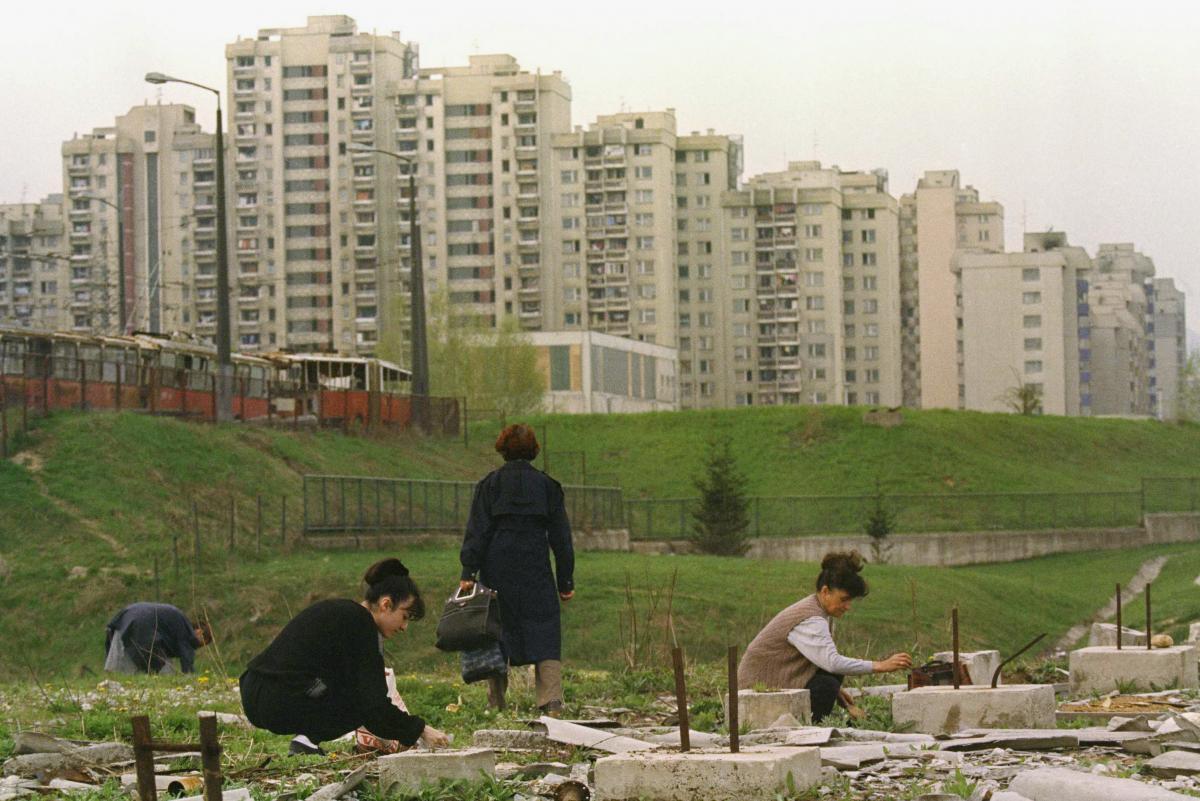
Sarajevo residents in April, 1993 picking wild plants along the infamous Sniper Alley, (the city’s main boulevard, where more than 200 people were killed and more than 1,000 wounded by Serbian sharpshooters during the war). A local publisher produced a pamphlet telling readers how to make nutritious meals from dandelions, nettles and other unusual food sources. (Photo: Jerome Delay, Associated Press)
The most laborious task, however, was fetching water. When the taps ran dry on the upper storeys of a building, Sarajevans would visit neighbours on lower levels to see what was left in the pipes. If a whole building ran dry, people would follow the water downhill, find working facilities, fill containers, and carry it back up again. Trips had to be made daily, and homemade water trolleys became ubiquitous. A typical example is the device built by Vefik Hadžismajlović, then the director of Sarajevo’s National Gallery, to carry water from his workplace to his home. A 20-litre plastic jerrycan was bound with rags to a wooden board mounted on the wheelbase from a suitcase. It was a practical solution, but only a partial one: he still had to carry the water up the stairs to his fourth-storey flat, and over time the plastic canister softened and bulged over the plank.
The queues at public cisterns were so long, and the labour of getting water home so arduous that people left their taps on, keeping an ear out for the sound of dripping. Elma Hodžić, now an art history graduate, was three when the siege began. She has an early memory of waking one night to see the moon shining up at her from the bedroom floor. Her grandmother had stored potatoes in the kitchen sink, and one had rolled over the plughole as the water came back on. The ensuing flood, a disaster for the family, was a moment of real excitement for the young girl: it was her first experience of bathing.
You seem to enjoy a good story
Sign up to our infrequent mailing to get more stories directly to your mailbox.Though she was young, Hodžić’s recollections from the war are nonetheless vivid. She has a particularly strong memory of the time her young mother ran out of shoelaces to use as wicks and began cutting strips from her dresses to serve as substitutes. The wicks were for their kandilo, a rudimentary, long-burning lamp made by pouring water and a little oil or fat into a container with a floating wick. The name and basic design of the kandilo are derived from the hanging lamps in Serbian Orthodox churches, but Fatima Dizdarević remembers being introduced to it by a neighbour and chemistry professor who gave her a homemade version as a gift. Word spread quickly, and along with water trolleys and tin-can stoves, the kandilo stands as a defining object of the siege. ‘They were the worst thing ever’, remembers Hodžić. ‘When you woke up in the morning your nose would be full of something really black from the candles, and the walls would be yellow.’
One effect of the flood in the Hodžić household was the disintegration of their parquet floors. At first, the wooden blocks were used as toys by Elma and her brother, but eventually all of them found their way into the stove, along with Elma’s Lego bricks and her mother’s high heels. Burning solid fuels—from wood to books to cloth to plastic—was an obvious solution to the lack of reliable electricity and gas supplies. In the written testimony that accompanied the donation of his improvised stove to the Historical Museum of Bosnia and Herzegovina, journalist Slavko Nastić describes the situation: ‘In June (1992), my neighbours started making fires behind our building to cook food. It was a collective fire. We would all wait in turn, but some brought wood and some didn’t. I soon abandoned the idea of collectivism and set about making my own metal stove.’
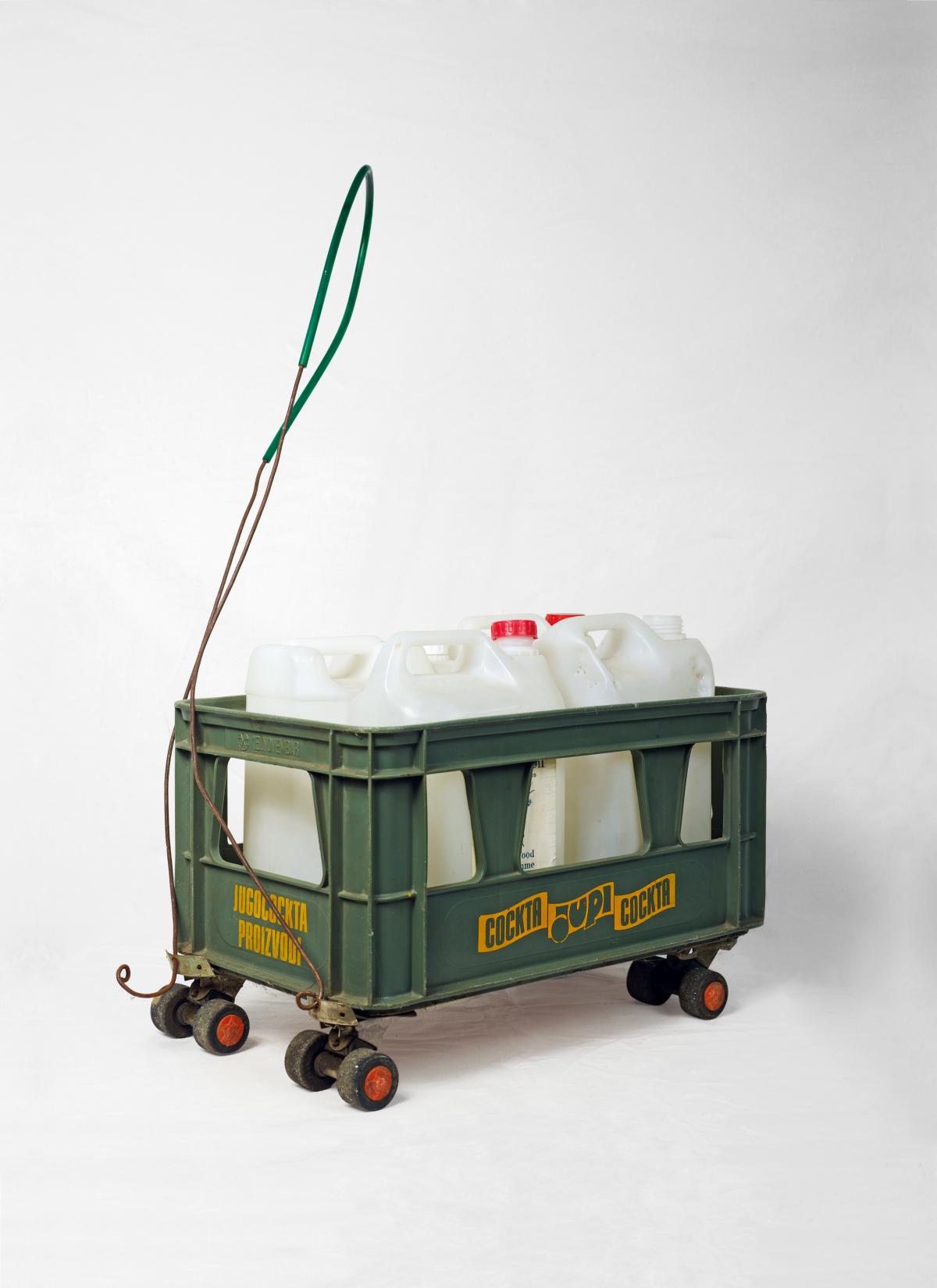
Bringing water home from Sarajevo’s wells was a daily mission and one of the hardest challenges for the city’s inhabitants. Wheels were salvaged from suitcases and skateboards to make the task manageable. (Photo: James Mollison)
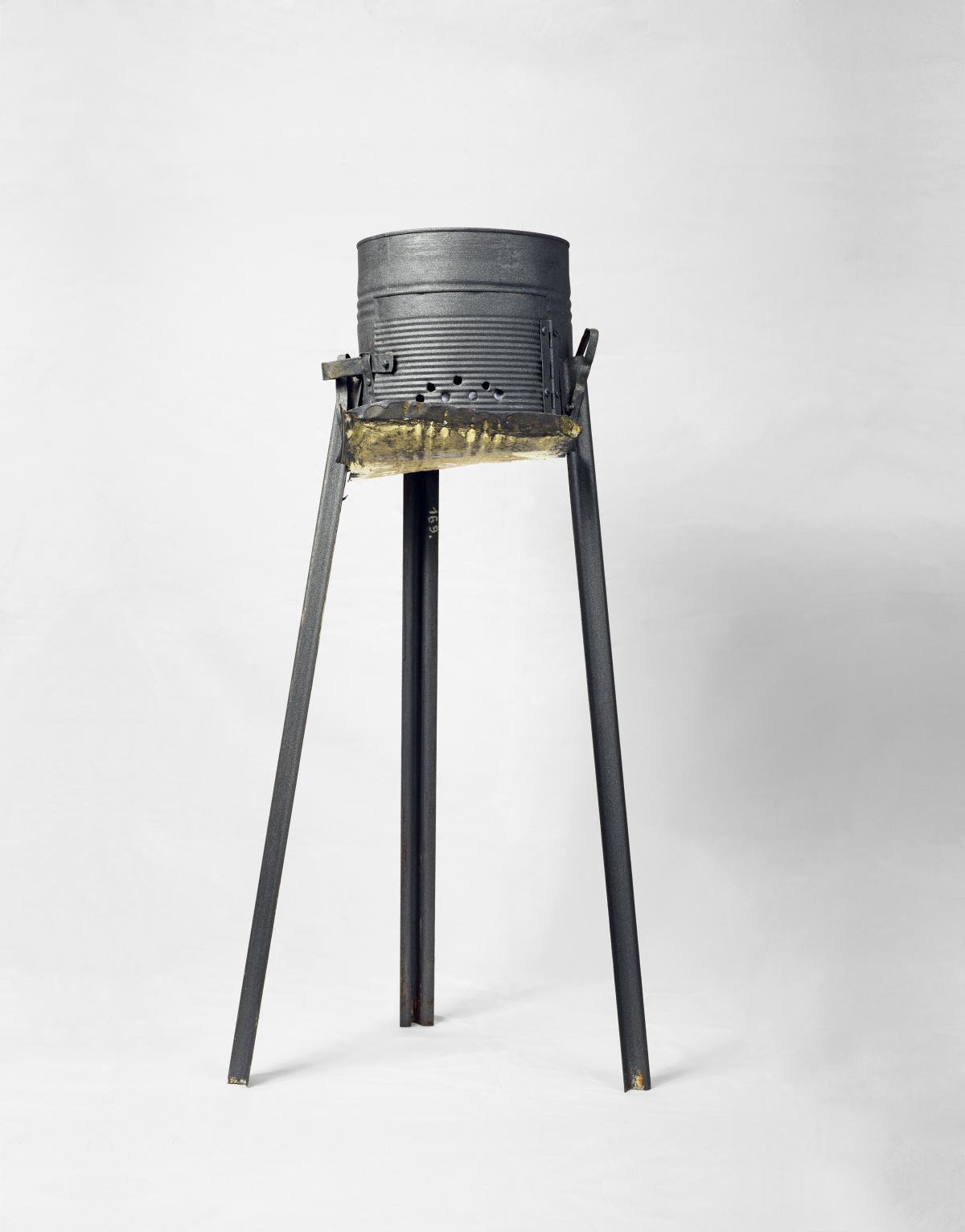
A signature design for stoves rapidly emerged: three legs supporting an empty five-litre humanitarian aid tin, the most widely available source of metal. (Photo: James Mollison)
Nastić began by foraging for material in an old, derelict hospital building. What he found determined the dimensions of his 30cm (1ft)-high stove as, using one small welder and nails beaten into rivets, he installed a barbecue gridiron to function as a fire grate and placed metal plates within the oven to slow air circulation and conserve heat. The whole thing stood on long legs, such that a short stovepipe, without any need for extra joints, could reach his home’s chimney, 65cm (2.1ft) above the floor.
During the siege, design ingenuity was often about more than the individual, physical need to survive. In 1992, Stjepan Dedović was a successful Sarajevo architect, but the war transformed him into a full-time caregiver for his wife, who had been left immobile by a massive stroke. Her condition required that she be washed daily, more than doubling the volume of water Dedović had to supply. Nearly 70 years old at the time, he provided for them both, carrying water three times a day 2km (1.2mi) from the nearest well and up the stairs to their fourth-storey apartment. Bombardment was a constant threat. A shell partially destroyed the roof of their home, and once, while he was fetching water, two men were blown to pieces in front of him. He kept walking, straight past the bodies.
Today, Dedović is a tall, strong 90-year-old with a gentle face and an infectious laugh, who warns, correctly, that he ‘is older than he looks’. Despite his good humour, his is a story marked by profound personal tragedy. One day, a mortar landing outside his building killed his 11-year-old granddaughter on the doorstep of his home. Struggling with the loss, Dedović continued to care for his wife, but she too died before the war’s end.
The frequent mortar shelling took a heavy toll on residents. Yet amidst this devastation, Sarajevo witnessed an incredible blooming of cultural production. It is estimated that during the four years of siege Sarajevans produced some 182 theatre events, 170 exhibitions and 48 concerts.
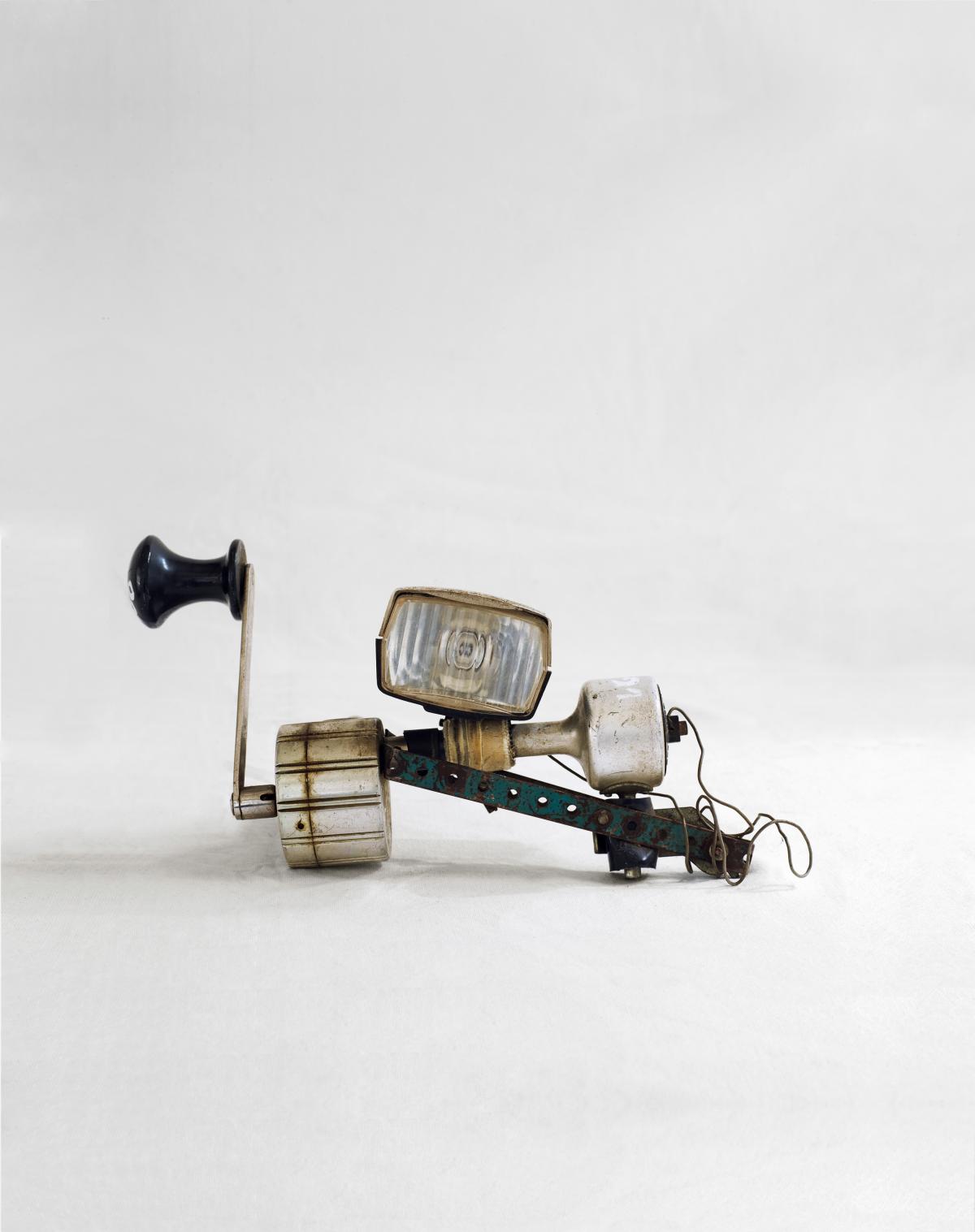
Hand lamp made from cannibalised bicycle parts and powered by the handle of a coffee grinder. It was built by Vlade Radišić during his service in the 101st brigade of the Bosnian army from 1993 to 1995. (Photo: James Mollison)
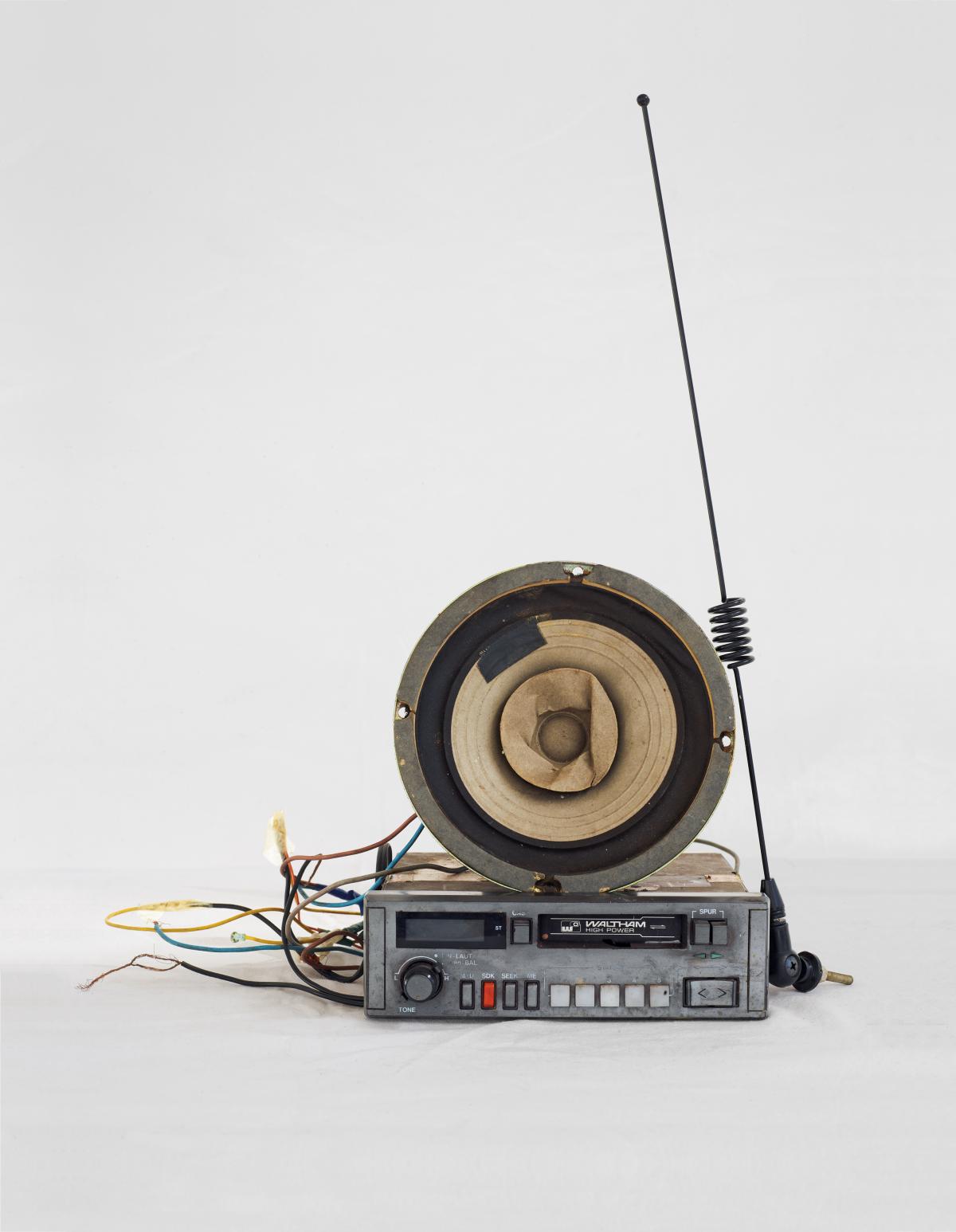
Radio put together from salvaged components. Low-powered appliances such as this would run on car batteries prised from vehicles with empty tanks and nowhere to go. (Photo: James Mollison)
To make life bearable Dedović directed his attention to building sophisticated home improvements, which he documented with technical drawings and tongue-in-cheek titles. The pišalo, or ‘pisser’ was a device for conserving water by channelling it into a pressurised stream. A weight attached to a pulley suspended one end of a thin, flexible tube, while the other rested inside a full five-litre (1.3gal) jerrycan. With one hand, he could pull the open end lower than the jerrycan to unleash a thin, forceful jet of water.
His other inventions included a hinged door in a gutter to collect rainwater, a device called the ‘launcher’ that directed the light from a candle, and the ‘rattle’, a non-electric doorbell that announced visitors by shaking a can of pebbles in the kitchen. Dedović’s greatest creation, however, was a highly efficient stove. A sliding drawer at its base allowed him to modulate air intake at one end, while twin exhaust flues crafted from food tins provided excellent ventilation at the other. The setup made it possible to cook an entire meal on the energy produced by burning a single piece of parquet floor.
As the siege progressed, a standard design for solid fuel stoves began to emerge, based on one of the most widely available sources of metal in the city: used five-litre (1.3gal) cans from humanitarian food aid. These large, empty tins would be set on three flat strips of metal bent outwards into feet at the end. On one side, a door was installed over a window cut out of the can, and on the other a stovepipe jutted out, providing ventilation. On many of the stoves, design signatures such as the neat styling of their hinged doors identified the tradesman that made them. Rather than build their own, people would buy these stoves from small craft workshops for 100 to 150 Deutschmarks (approximately US$100–150 or €78–117 today), giving rise to an economy that turned rubbish into valuable survival items.
Inspired by this simple design (and perhaps deterred by the price), some built imitation versions. On display at the Historical Museum is the stove built by Professor Enver Imamović, a respected archaeologist and historian, at that time the director of Sarajevo’s National Museum. Its door may be roughly rendered, and the stovepipe crudely fashioned from an old meat tin, but all the elements of a classic workshop-made, five-litre-can stove are visible, right down to the three metal strip legs, which, though serviceable, are attached back-to-front.
Ultimately, shelling would blow the glass from almost every window in Sarajevo. Before it did, those living in modern apartments knocked holes through external walls to make space for the chimneys needed by their new stoves. Most households ran on electricity in pre-war Sarajevo, but as anthropologist Ivana Maček writes in her 2009 book Sarajevo Under Siege, ‘toward the end of 1993, and especially in 1994 and 1995, the gas network was extended.’ Wood was expensive as early as 1992, notes Maček, at 200 Deutschmarks (US$200 or €148 today) per cubic metre, and gas, though only intermittently available, and then only in small quantities, was a smart option. ‘The streets were crisscrossed by ditches for new gas pipes that led from one house to another,’ she writes. Installed by amateurs, these ‘plastic pipes with leaky joints’ ran unprotected across apartment floors. Explosions were common.
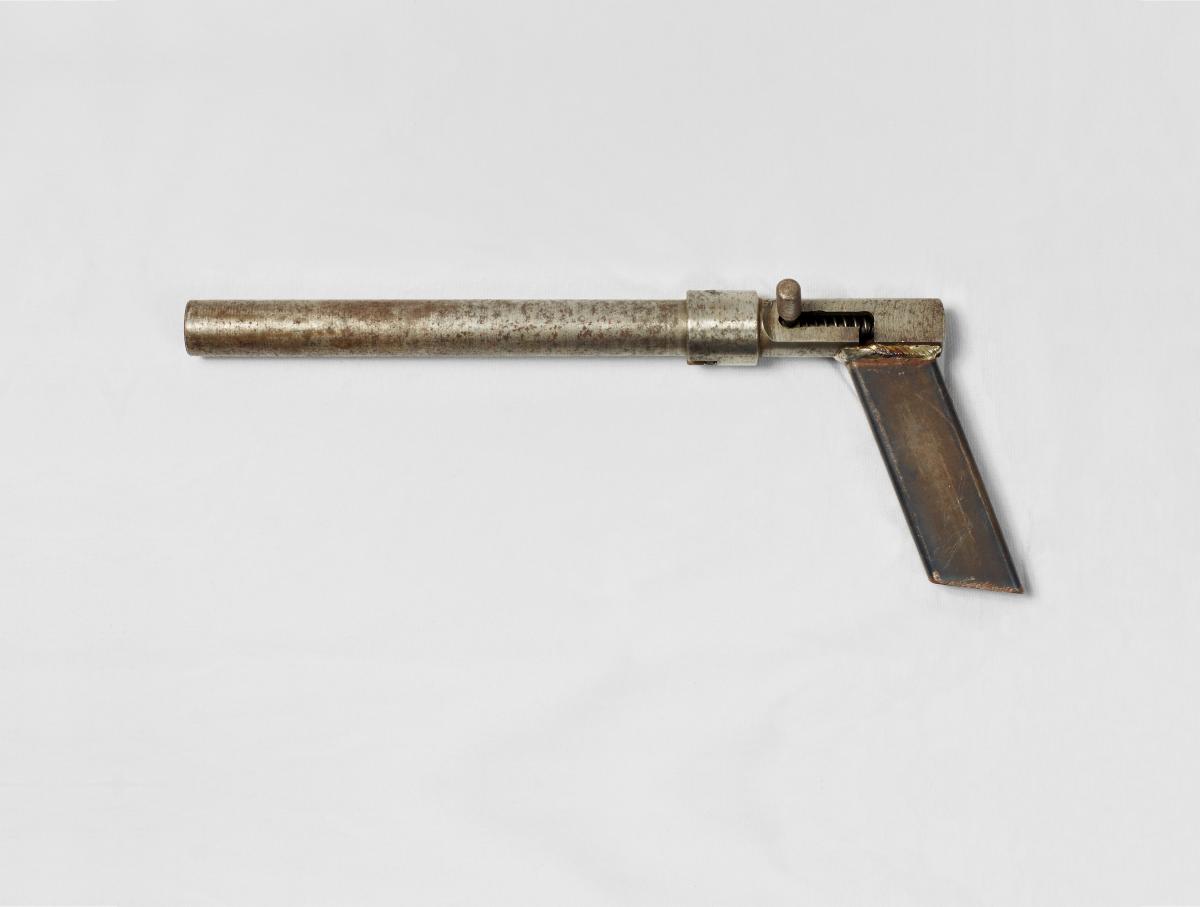
Improvised guns were among the only weapons available to Sarajevans in the first year of the war. They were produced from scrap by at least 12 machine shops in the city, including what had been the 2nd Government Technical School and a small art college. (Photo: James Mollison)
Amar Karapus, now a curator at the Historical Museum of Bosnia and Herzegovina, remembers one such incident from the winter of 1993. His neighbour, a deaf-mute who lived in a first-storey apartment across the street, was returning to his flat from drinking coffee with friends in one of the flats above him. As he opened his front door, he reached inside for a kandilo, took it out, and opened his cigarette lighter. The ensuing explosion threw him back ten metres (33ft) down the corridor and entirely destroyed his home. He survived, but such blasts could easily be lethal, and were caused as much by leaks as by fluctuations in the gas supply. Holding up a steel gorionik, a gas burner small enough to fit into an improvised oven in place of wood, Karapus points out an extra hole drilled into its supply pipe. Sitting outside the cooker, a flame from this opening was both pilot light and visual warning: if it went out, the cooker was a bomb.
‘We used gas for everything,’ says Emir Fejzić, an architecture professor at the University of Sarajevo. ‘But gas is a strange substance. It produces a great deal of soot, which gets everywhere, even between the pages of a closed book.’ By early 1994, he had decided to start work on an electric generator. A racing driver who competed at the national level before the war, Fejzić knew his way around cars and combustion engines, but had little experience with electricity. He joined forces with Jurić Mira, a graduate in electrical engineering he knew from the construction company where they both worked.
Although the company’s workshop had been destroyed at the beginning of the siege, they found steel shelving and an electric motor from a universal carpentry machine among the ruins. By coupling a salvaged petrol engine from a Zastava (a car marketed internationally under the brand name Yugo) to the drive shaft of the electric motor, they could use it to generate, rather than consume, voltage. The engine itself would run not on petrol, but on natural gas. ‘In theory, it was dangerous,’ says Fejzić. ‘But not in practice.’
The last thing they needed was a water pump to cool the engine. At a part of the Miljacka river sheltered from direct fire, Fejzić spotted a submerged Zastava 750. The water was running high, but Fejzić waded in, reached beneath the surface and worked blind, using the knowledge from his racing days to extract the necessary component. He stood in the current for 30 minutes before he managed to work it free.
‘Everything was disordered in the war,’ says Fejzić. ‘It was chaos. Everything depended on how you looked at that chaos.’
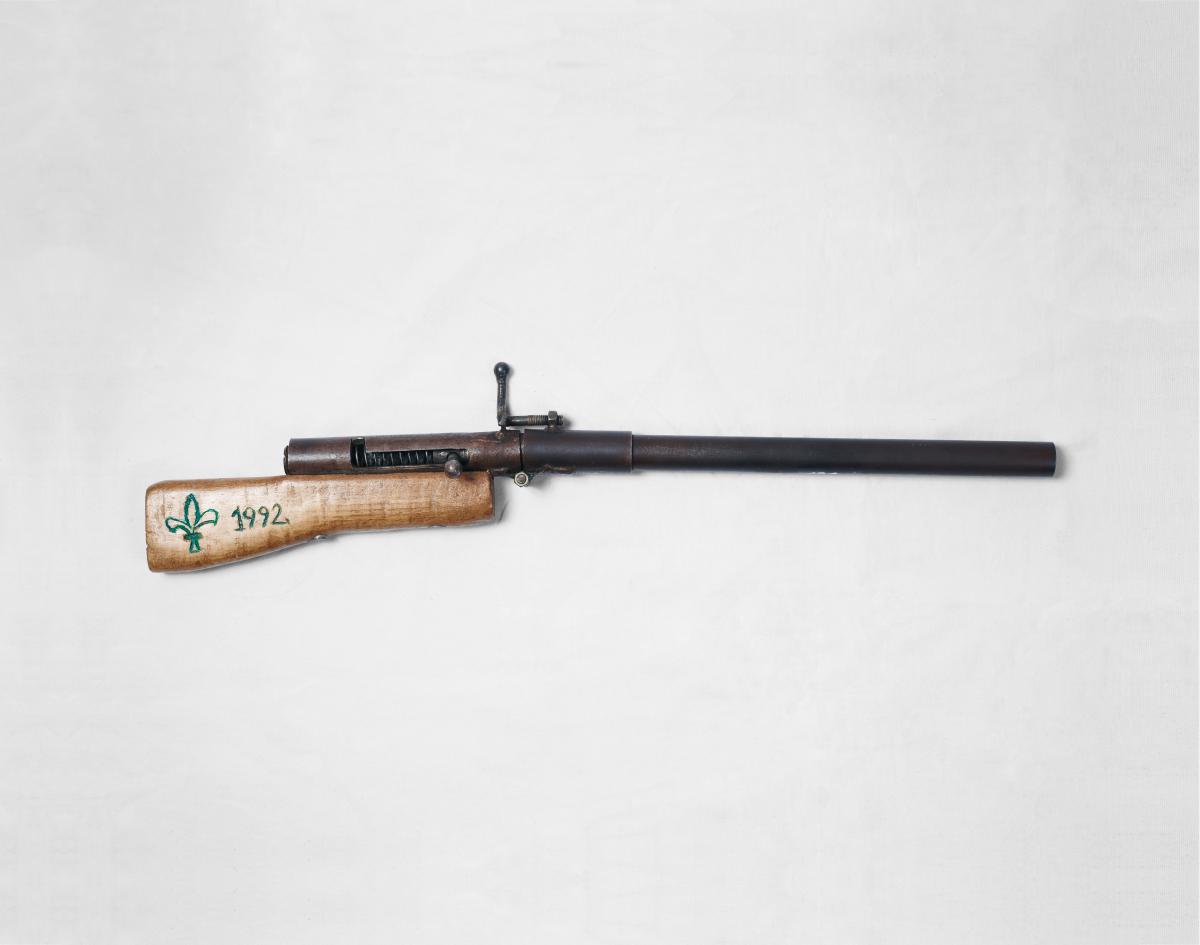
(Photo: James Mollison)
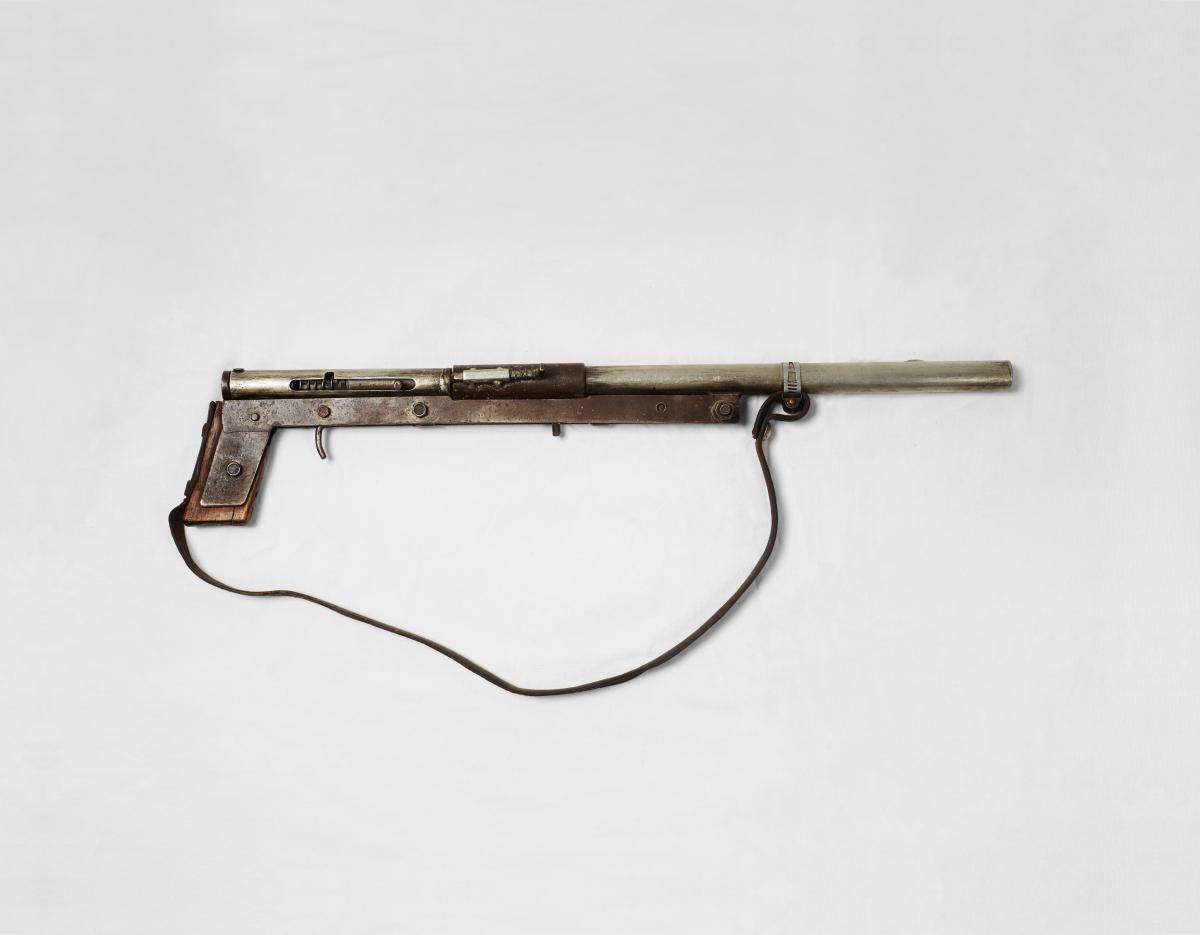
(Photo: James Mollison)
The generator was designed to create enough electricity for nine families to power one bulb and a fridge. ‘We planned for around 250 watts per flat,’ says Fejzić. That summer, after six months of work, he and Mira switched on the machine for their excited neighbours. It worked perfectly, but two days later it was switched off and has stayed off for 20 years. ‘People were not satisfied,’ explains Fejzić with a shrug. ‘The generator sucked up the whole building’s gas supply. They could only use electricity, but there wasn’t enough electricity to cook. They chose gas.’ Furthermore, the generator’s operation depended on absolute secrecy. Sarajevo’s military police often confiscated such machines for their own use: the generator would need to be hidden, and everyone involved had to be privy to its existence.
‘We were all working as individuals,’ says Fejzić. ‘We weren’t organised. We didn’t agree.’ Perhaps the Sarajevan collective spirit was not up to the ideal standards of the socialist Yugoslavia from which Bosnia emerged, but to anyone brought up in the individualistic societies of Western Europe or the USA, the extent of collaboration was remarkable. Self-organising communities were the norm in besieged Sarajevo. On a large scale, entire neighbourhoods of four or five buildings would work together and allocate tasks, but even in small communities, individual roles were mutually understood and respected: on the eighth storey of 11 Kolodvorska Street, for example, Stevan would bring fuel and food for the group while Mustafa constructed their stoves and pans.
This instinctive push towards collectivism even influenced the Bosnian army’s improvised design efforts. In a stapled booklet apparently produced with a Commodore 64 and a dot-matrix printer, the 9th Mountain Brigade of the 4th Koscan Battalion detailed their attempts to turn a captured Serb nationalist armoured car into a tank. Dubbed the T94 in a cheeky nod to the T-series of Soviet battle tanks, the minutes of the 74 meetings they convened to discuss its construction are recorded in their ‘Work Diary’. Here is a typical entry:
*June 15, 1994 Today we were supposed to pick up and tow the machine for the T94, but couldn’t find a truck.
- Šerif says his is broken.
- Osmo, flat tire
- Alijos says his has no gearbox, but he’s lying
- Kemo’s engine has overheated
- Džemil’s bearing is broken, and that’s actually true
Commandant Ešo couldn’t persuade Kasum from Tarčin to do us a favour, so we gave up.*
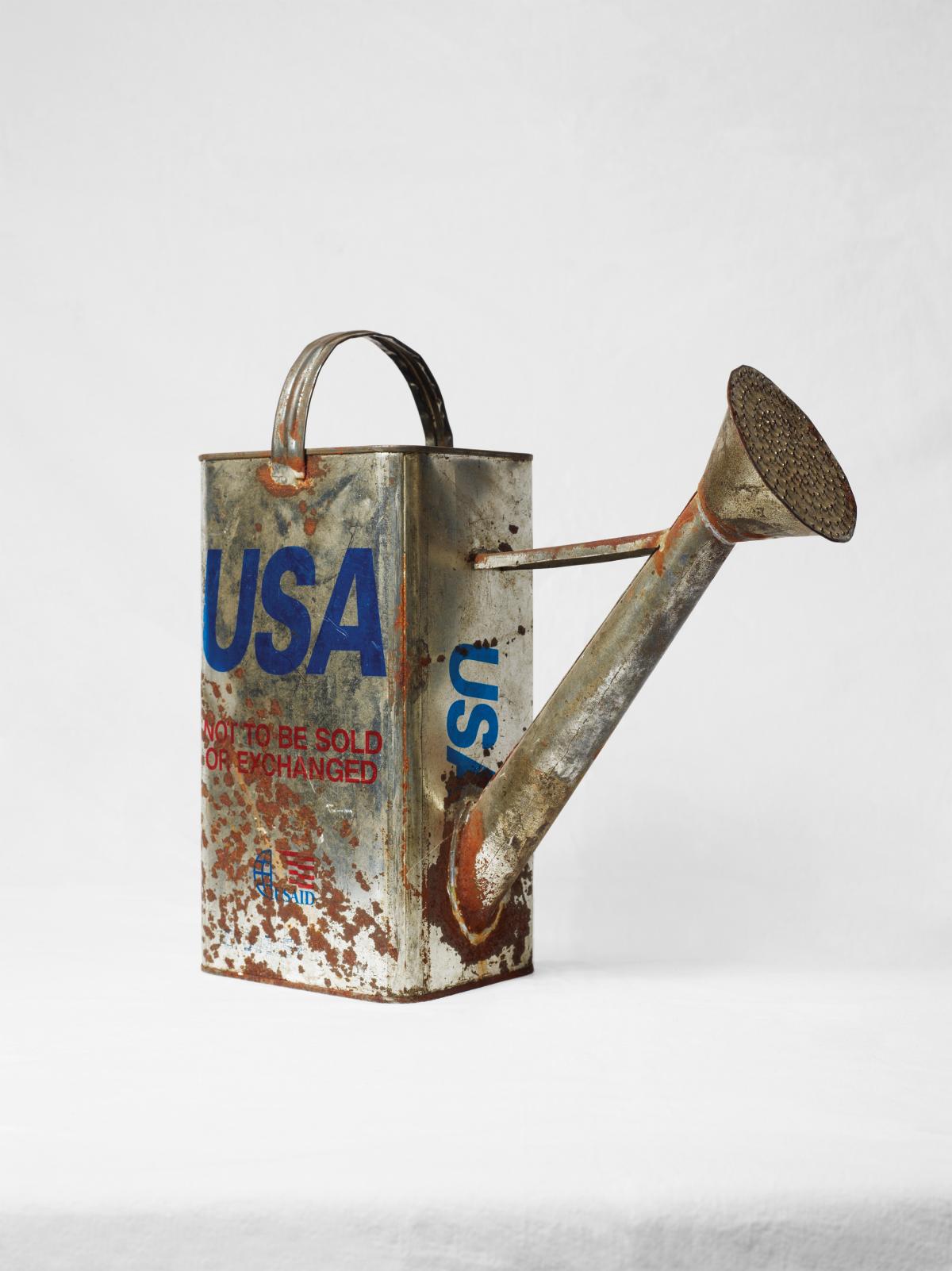
One of several identical handmade watering cans donated to the museum by Vesna Bebek. As the war progressed, Sarajevo’s more sheltered public spaces were turned into allotments tended with water carried by hand. (Photo: James Mollison)
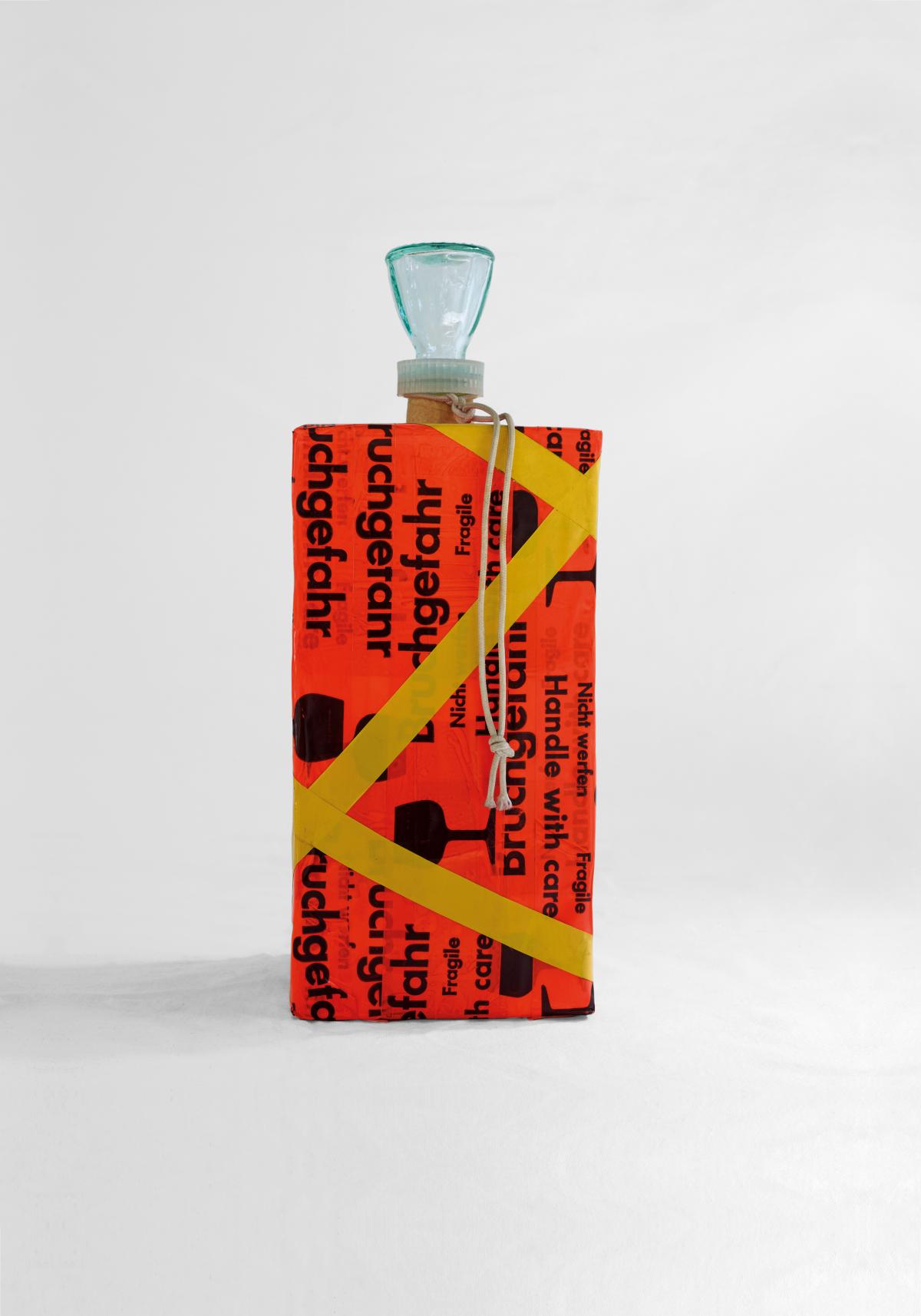
Thermal flask made by Vefik Hadžismajlović, then director of the National Gallery in Sarajevo, from a glass decanter wrapped in polystyrene and cardboard. (Photo: James Mollison)
From the outset, the defence of Sarajevo was left to a loose collection of militias formed by volunteers according to the street they lived on, their common age, or other unifying, if arbitrary bases. The process of joining them up began in 1993 and never really ended. ‘There were so many funny situations,’ remembers historian Mirsad Zorabdić, then an advisor to Ejup Ganić, the deputy president of Bosnia and Herzegovina. ‘They were self-organised, and everyone had been educated under socialism, so they always wanted to vote and discuss things. They wouldn’t just follow orders; they would try to make communal decisions.’
In the year leading up to the war, the Serb-dominated Yugoslav People’s Army systematically confiscated all the weapons from the Sarajevo garrison. When the fighting broke out, the 200 guns kept by guards at the local prison were the only military-grade weapons left in the city, remembers Zorabdić. Another 300 to 400 hunting weapons were added to the Sarajevo arsenal, along with a few illegal pistols. A September 1991 UN embargo stopped supplies of arms to all territories in former Yugoslavia, by which time the Serb nationalists had already been well equipped by the Yugoslav People’s Army. With no chance to buy or import weapons, the Sarajevans were forced to make their own.
At least 12 different workshops around Sarajevo devoted themselves to building guns, including the 2nd Government Technical School and a small arts and crafts college. Most of the weapons they made had barrels built from water pipes, with a bolt on a spring that was pulled back and released onto the percussion cap of a shotgun cartridge. Such a gun could be as dangerous for the man firing it as it was for his target; at least one soldier lost his nose when his home-made weapon exploded.
In the extreme circumstances of the war, Sarajevans responded by making something out of nothing, using discarded materials and broken machines to improvise stoves, weapons, water collectors, lights, anything that they needed to survive.
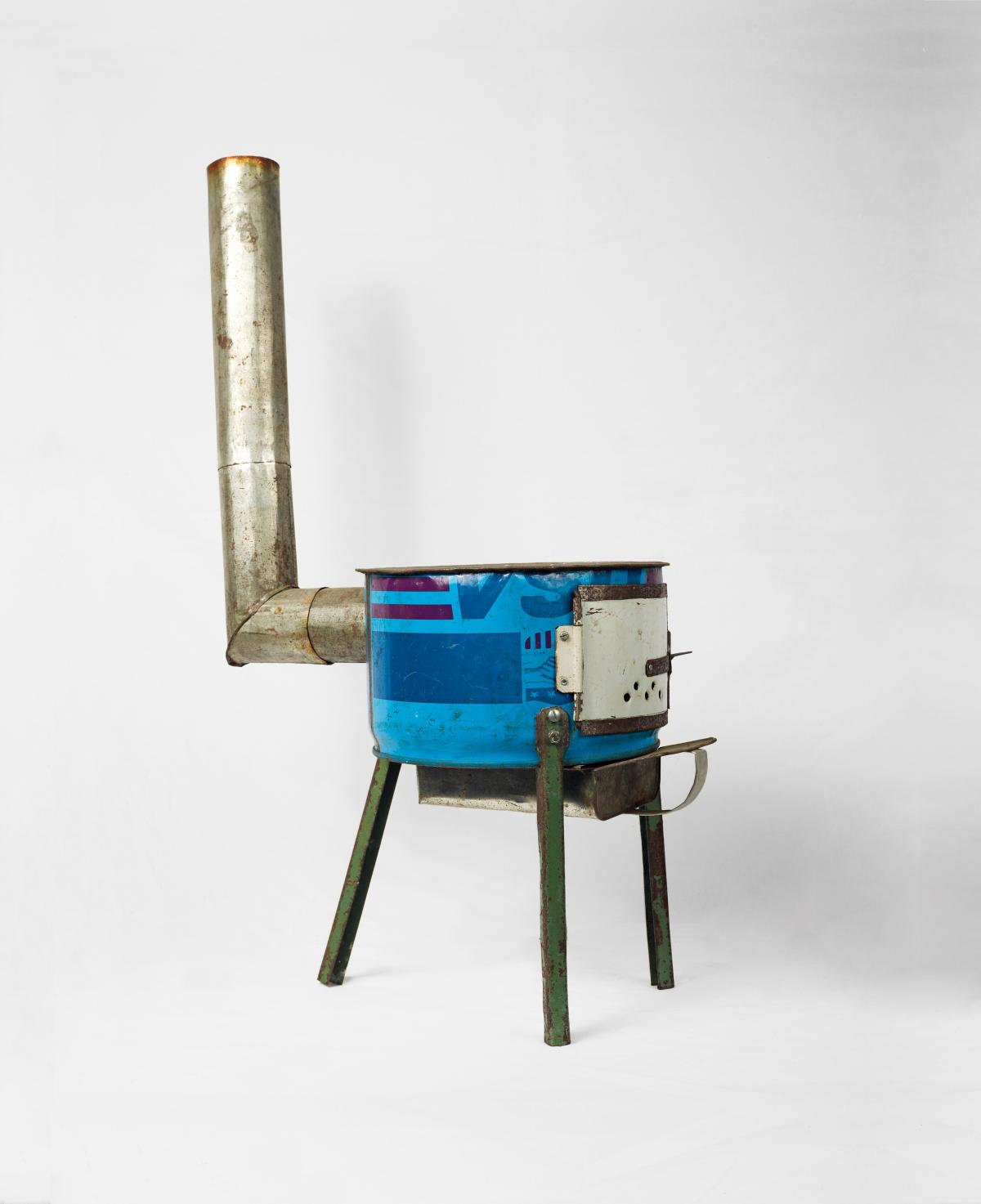
Before the war, most Sarajevans used electricity to cook and heat their homes, and when the supply was cut off, wood-burning stoves became the city’s most in-demand items. In 1992, a well-made version could fetch as much as 150 Deutschmarks (US$150 or €117 today). (Photo: James Mollison)
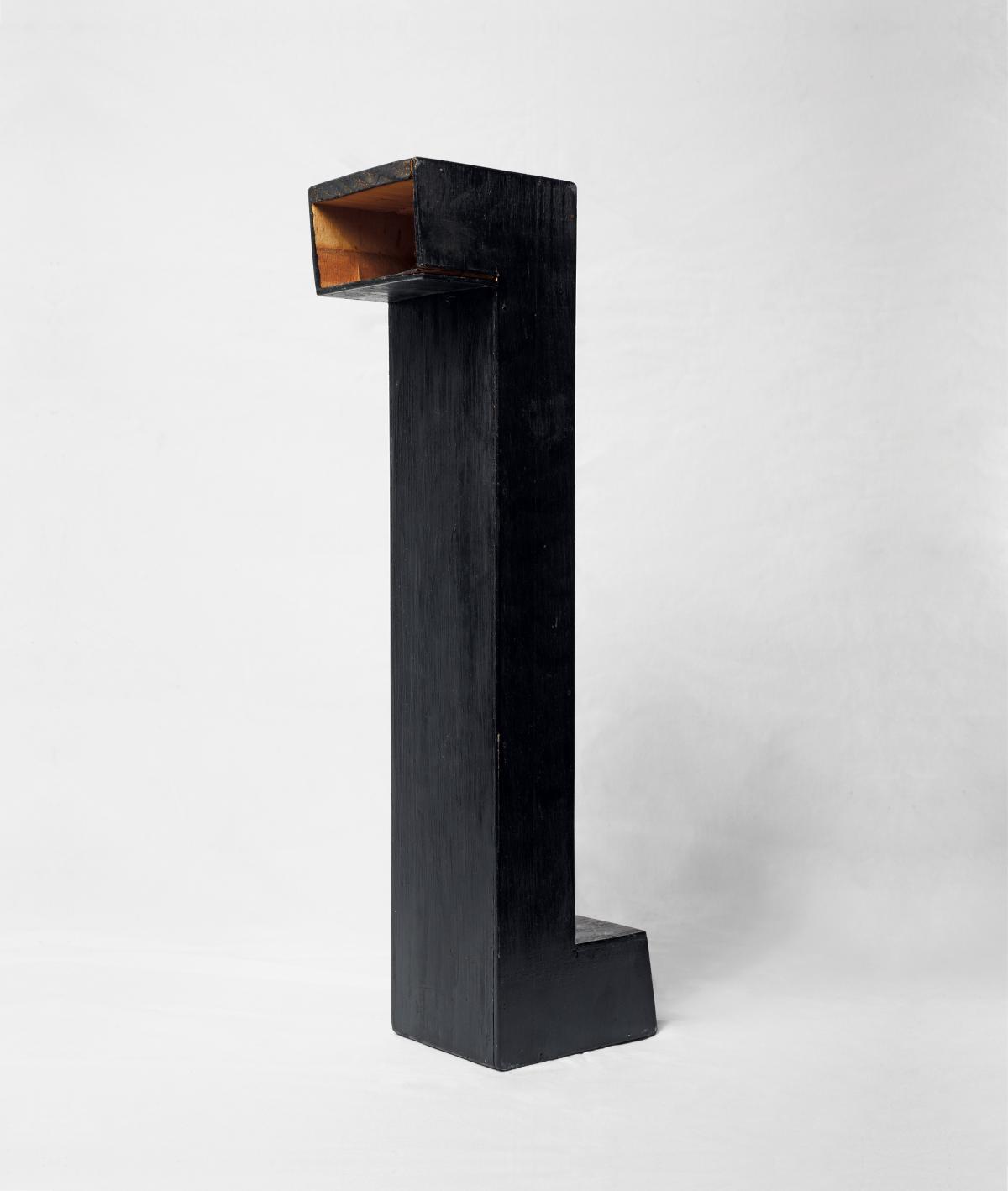
Handmade wooden periscope built by members of the Bosnian army’s 102nd motorized brigade. (Photo: James Mollison)
Supplied by hunting clubs, shotgun rounds were in plentiful supply at the beginning of the war, but by the end of 1992, the defenders were forced to make ammunition as well. First, cardboard rolled into a cylinder was covered over at one end. Gunpowder was collected from starting pistols or scraped from individual caps for a child’s cap gun, poured into the tube, tamped down, and covered over with stones and bits of metal. Just before it was fired, each cartridge was primed with a splash of petrol from a bottle or an injection of medical alcohol from a syringe. After ‘pulling the trigger’, up to 30 seconds could pass before the gun fired. ‘The feeling was terrible,’ Zorabdić remembers. The weapon had an effective range of about 10 metres, and its susceptibility to rain gave it its nickname: the ‘umbrella gun’.
Other defensive measures employed IEDs made from bent traffic signs, and bombs made from gas bottles, the latter intended to topple buildings onto Serb nationalist tanks. (It was in 1998, two years after the war, that these bombs were remembered and removed. ‘People were too busy eating,’ says Zorabdić.) Until a tunnel finished in July 1993 allowed AK-47s to be smuggled into the city, one weapon would be shared by three or four soldiers on the front line. Some even carried disabled Austro-Hungarian rifles from the Historical Museum just to give the impression that they were armed. ‘A gun was a gun,’ says Zorabdić. ‘Their role was more psychological than practical.’
Be that as it may, they were no less crucial in the defence of Sarajevo. ‘Drive them crazy,’ Mladić had ordered, and by refusing to let that happen, by preserving their dignity and maintaining a memory of normal life, the Sarajevans fought back. This psychological resistance, as much as the physical need for weapons, water, power, fuel and food, was a constant driving force behind Sarajevo’s improvised design culture. When people swapped recipes for coffee made from lentils, honey made from dandelions, or ‘war mayonnaise’ made from powdered milk and citric acid, they were constructing an image of themselves that refuted the horror around them.
In this essential project, humanitarian aid could be perversely unhelpful. Until 1992, Sarajevans had enjoyed a standard of living comparable to that in Western Europe. Tins of inedible ICAR meat from the EU and high-protein biscuits from the USA—fresh from cans with a 1968 expiry date—proved difficult to swallow. Having no choice but to eat it only made things worse. Productivity was a way to alleviate charity’s demeaning effects: Jekte Maršić, then in her eighties, made soap for her entire street with used cooking fat thrown out of the UN peacekeepers’ kitchen. It was greasy, and using it meant scraping leftover fat from your hands afterwards, but people chose to believe that it was good for disinfection. It made them feel clean.
In 1996, as suddenly as it had begun, the siege came to an end. ‘During the war we said all the time that when it finished, we wouldn’t think about material things,’ says Hadžismajlović’s wife Habiba. ‘That we would travel, do things differently. But people went straight back to their normal lives. They forgot everything and threw themselves into having the best furniture, a weekend house, and the nicest car.’ Her husband also feels a strange nostalgia: ‘People were never better than they were then. If someone invented something he would share it.’
‘For four years people were living in abnormal circumstances,’ says Elma Hašimbegović, director of the Historical Museum. ‘And when the war was over, they got rid of anything that reminded them of it. They took the plastic sheets from the windows and put in real glass, and they threw out everything they had used.’ Nonetheless, hundreds of stoves, ovens, guns and other handmade items survived. Now exhibited in the Historical Museum, they stand witness to a generation who, Hašimbegović says, ‘will talk about the war until the end of their lives.’ And when they talk, she adds, they don’t discuss ‘nationalism, the fighting or the destruction’, so much as swap ‘stories of improvisation’ about the things they made to survive.

